Conventus Eparchialis. The Legal-Institutional Status According to the Code of Canons the Eastern Churches
Abstract
Life of the Church from the very beginning was characterized by participation of the local community in solving the current problems connected with its existence. The eastern Canon Law appoints conventus eparchialis (eparchial convention) as the most important one among the organs supporting the eparchial bishop in managing the eparchy (diocese), in this way indicating its role and task in the life of the particular Church.
The origin of the term conventus (convention) should be seen in the Greek source term synodos, from which it was derived. The very Greek word synodos means “to take together a common route to an appointed aim”. Hence the discussed concept contains two elements in it: convention and solving common problems.
An eparchial convention is summoned by the bishop – its pastor. It unites the eparchial bishop, the clergy, monks and nuns in one living and active organism – communio fidelium. It has its own structure that reflects its constitutive elements. It has a representative character and presents the synthesis of God’s People of the given particular Church. An eparchial bishop has an opportunity to meet his Church at an eparchial convention, and a particular Church has the right to express its opinion in front of its bishop.
Apart from the pastoral dimension an eparchial convention also prepares particular legislation. It is supposed to be finalized in the form of an actual document with a legal character, through which it contributes to creating the good of the Church, for which it was summoned. The eparchial bishop also remains the only legislator, as it is he that promulgates the texts of acts, declarations and decrees that are binding for all the faithful living in his eparchy.
The institution of the eparchial convention emphasizes joint work, in which, through coparticipation, common responsibility is born for building an ecclesiastical community – a particular Church.
Copyright (c) 2010 Roczniki Nauk Prawnych

This work is licensed under a Creative Commons Attribution-NonCommercial-NoDerivatives 4.0 International License.


